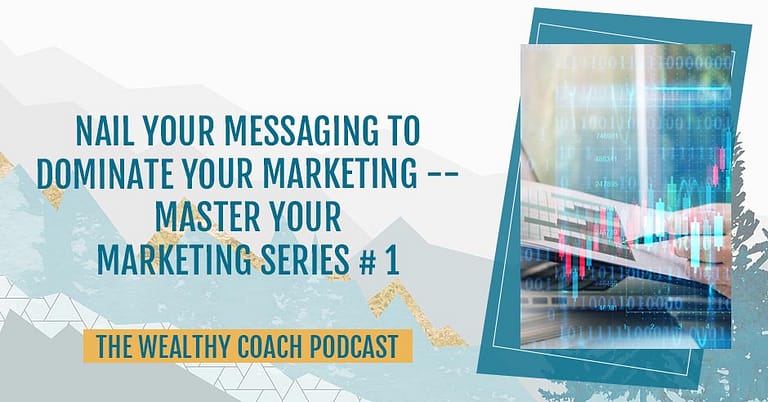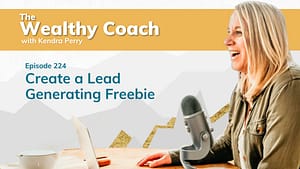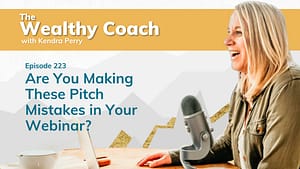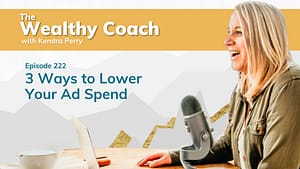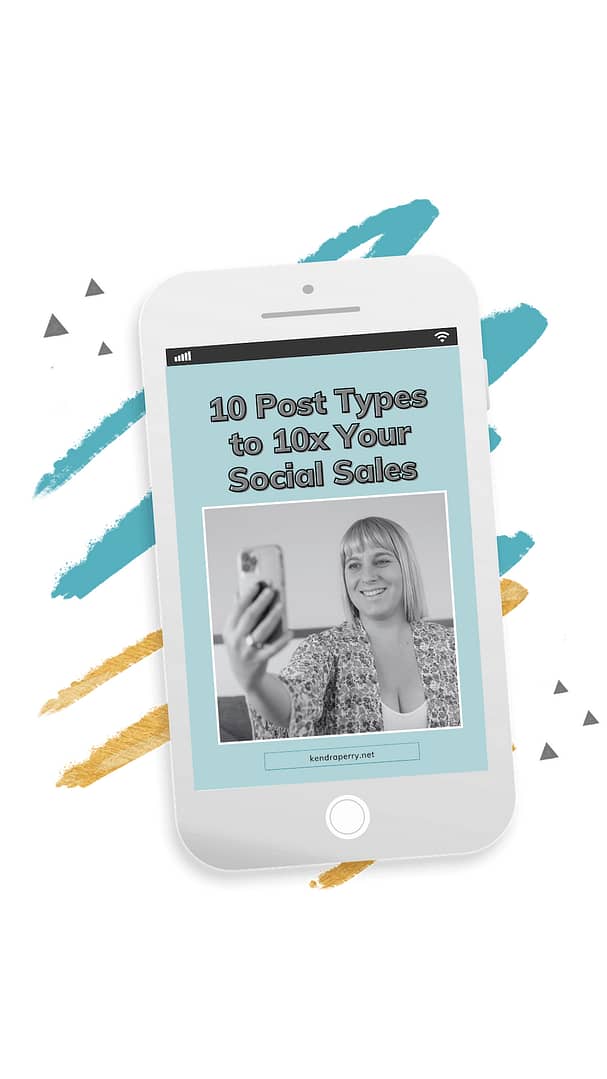Marketing is not just posting every day on social media. In order for it to truly work, there needs to be a strategy behind it. Everything needs to be intentional. While this might make marketing sound intimidating, Kendra Perry is here to assure you that it doesn’t have to be. With the Master Your Marketing Series, she demystifies and simplifies marketing the way you need it to, so you can make it work and achieve your desired results. In this first episode of the series, Kendra dives deep into the importance of nailing your messaging. After all, this is the foundation for your marketing. What is messaging? What are the types of messaging you need to know? How do you create the right message? Find out the answers to this question and more as Kendra shows you how to craft the message that best reflects you, so you dominate your marketing!
Apply to work with Kendra inside her 6-month Mastermind Program: https://kendraperry.net/apply
—
Listen to the podcast here
Nail Your Messaging To Dominate Your Marketing – Master Your Marketing Series # 1
I am excited to be here. It is a beautiful day in October 2023. I love the fall colors and everything’s popping right now. The leaves are popping and the sky has been blue. We have had very little rain and lots of sunny days. It’s been fantastic. I’m getting back from a 36-hour trip to America and I went to America for Canadian Thanksgiving, which is a little bit weird, but I always forget when holidays are and I’m never thinking of them, and we booked this trip well before we realized that it was Canadian Thanksgiving.
It’s fine because my partner Ryan’s parents are in Portugal right now. We did a little Friendsgiving with some of my friends and then we spent the actual holiday Monday in America because I went down for some blood chemistry to get some bloodwork done. After all, our labs are a bit lacking in Canada.
I’m a biohacker. I love running labs and I wanted to run a Cyrex panel. I can’t remember the array name, but it’s the pathogen screen because I have been running the GI map for years. It’s always pulling up the same stuff and I have had this stubborn H. pylori infection for several years and I have thrown the kitchen sink at it. I have spent thousands of dollars trying to get rid of it and it’s not going away, which is annoying.
I’m trying to see if there’s maybe something else that I’m missing and so I decided to run this other test. The GI map is this poop test and mine pretty much always looks the same for the past several years and there are no other clues on there. I thought that maybe there’s something else that’s driving it or allowing it to be there.
This is a blood test where they are looking at the immune response to a whole range of pathogens, but I can’t get it done where I live. I already tried. The lab doesn’t have the proper technology and it’s like a 24-hour overnight shipping or something like that, but I live pretty close to the States. I’m about 30 minutes or so from the border, and I’m close to Spokane, Washington. When I say close, it’s about three hours. It’s not like it’s super close, but I was like, “Why don’t we turn this into a trip?”
We found a comedy show. We brought our bikes. There’s this little mountain biking area outside the city. We went there. I got my ass handed to me because I haven’t been biking. I haven’t been into it that much. I got worked and then we stayed at the historic Davenport Hotel, which is this old hotel that was built in the ‘20s. Inside it looks like the ‘20s and it was cool.
We spent the night there. We went out and had a nice dinner. We found an amazing restaurant. Shout-out to Wooden City in Spokane. I know they have other locations. It’s fantastic. The service was fantastic. It was a great experience. We loved it. We went to see this comedian. I cannot remember his name, but he was awesome. He was very raunchy, outrageous, and offensive which honestly, I like because we take things way too seriously in this world. I wanted to laugh at lots of ridiculous things. That was fun. The next morning, we got up. We had breakfast and we came home. It was like 36 hours in the US but I got my bloodwork done and I’m very excited to see the results.
Master Your Marketing Series
Enough about me. You probably don’t care about my 36 hours in the States, but I want to dive into the Master Your Marketing Series. This is episode one of the Master Your Marketing Series. This is a five-day series. I’m going to be dropping episodes every day. We are going to be talking about marketing. This is going to be good for you whether you are new or even if you are later on in your business.
Even if you are making $5,000, $10,000, or more a month, this is still going to be relevant, and my intention is to simplify things for you. Breaking things down and showing you how everything fits together because marketing is intimidating. A lot of us don’t even fully understand what marketing is. We think marketing is like, “I’m posting every day on social media.” That is some marketing, but there needs to be a strategy behind everything and everything needs to be intentional.
What we are going to be covering? Now, we are going to be talking about messaging, which forms the foundation for your marketing. On Day 2, we are going to be talking about organic marketing, and on Day 3, we are going to be talking about ads and paid marketing. On Day 4, we are going to be talking about live launching, and on Day 5, we are going to be talking about automated launching. Everything is going to be released on the day that it’s released, and I hope you enjoy this series. If you have any questions, you want to give me any feedback on the series, even if it’s to say, “I love that. Can you do it again?” shoot me a direct message on Instagram. My handle is @KendraPerryInc.
Nail Your Messaging
Let’s dive into day one. Nail your messaging to dominate your marketing. This is the only way you can dominate your marketing. If you don’t have the right messaging in place and it’s not connecting with your target audience, all of your marketing isn’t going to work. This is something that I came up against in many of the first years in my business and it’s also something that I continue to work on.
Messaging is critical because if the messaging doesn’t connect with the target audience, then all of your marketing efforts, your launch, your organic marketing, and your paid marketing isn’t going to work, and then we are going to say something like, “Marketing doesn’t work,” and that’s not true. Marketing always works. It’s a matter of when, but again, if the messaging is off, the marketing won’t work.
We have to go down to the core foundation of marketing, which is messaging, and we always have to start with messaging. Just in case you are like, “What is messaging?” messaging is how you talk about the business and the value that it offers. It refers to the core value propositions, key points, and language that you use to communicate your brand services and value to the customers and the target audience.
It is a strategic effort to shape perception, build brand identity, and influence consumer behavior. I know that’s a bit of a mouthful. Let me simplify this for you. Messaging is communication. It’s the way that you talk to your target audience. It’s the way that you talk as a business owner, and it’s the way that you talk about your offer.
That’s why it’s so important because you can imagine if you can’t communicate with someone in your life, for example, if you are trying to be in a relationship with someone, maybe you started dating. If you guys can’t find a way to communicate, the relationship is never going to work. It’s the same thing between you and your audience because you are essentially entering into some form of a relationship with your target audience. If the communication is off or you are missing each other, then, again, that relationship’s not going to work.
#1 Target Audience Messaging
There are three different types of messaging and I want to talk about all three of them. I want this series to be incredibly valuable to you. There is target audience messaging, brand messaging, and product messaging. Let’s start with target audience messaging. This starts with the niche. This is the messaging or the communication that speaks directly to the target audience, and it has to use language that they understand and that language needs to relate to their interests, needs, and challenges.
A lot of people get this wrong because they make a lot of assumptions about their target audience and what their interests, needs, wants, and challenges are. This is something that I often see with new practitioners and coaches. They have figured out a niche, and the niche is good. It’s profitable and I can see that in their bio on their Instagram.
When I go look at their content, the content is all over the place and it’s disjointed. I did a challenge. A free challenge. It was awesome. It was the most fun I ever have had in a launch. It was so great. I’m going to be breaking down everything I did for that in a future episode of the show. Something that I showed everyone was the last nine posts of several different coaches’ Instagram. That’s the feed. There are nine posts in a square. I didn’t show them their bio and I said, “Who does this person serve?”
The audience was able to guess everyone’s niche without seeing their bio. This is important because the information has to be relevant. It has to connect and, with a lack of a better term, you need to dumb it down. What I mean by that is not that you need to make stupid content for stupid people because that’s not what I’m saying. I mean you need to simplify it. You need to put on the hat of your target audience who is way further behind in their journey than you.
You are the expert. You are a whole bunch of steps ahead. You have gone to school. You have done education. You love your craft, health, personal development, spirituality, and whatever it is. You love it. You read about it and you consume it all the time, but that’s not your person. They are not passionate about it. They are not educated on it. You have to make the very obvious connections for them.
For example, if you are out there saying that you help women with their gut issues, and then I see a post about a bladder infection, I know as a health coach that a bladder infection could be connected to issues in the gut, but your person doesn’t know that. If you are going to post about something like that, you have to simplify and show them why they should care. This is something that I call going beyond the niche. We need to go beyond the niche. Good messaging makes your target audience feel like you get them better than anyone else. They feel seen by you and heard from you. They think, “This person understands me. They get me. They get it.”

I’m going to use this example. I have used this before on the show, but I think this will help you. When it comes to having solid target audience messaging, it’s about speaking to the target audience’s lived experience in relation to who they are and the problems that they have. For example, in my twenties, I had a problem with acne and I was very self-conscious about it.
I was also very social and I was a partier. I used to go to a lot of house parties and I was going out all the time. I used to navigate the room that I was in based on the lighting. For example, in a house, typically the brightest light was in the kitchen. I would avoid standing in the kitchen because I knew the bright lights would make my acne more noticeable to people in the room, and I would feel more self-conscious.
I would hang out in the living room or the dark corner somewhere because there, I felt more confident. This is a strange thing to consider if you have never had acne and you have always had good skin. You are probably thinking, “I didn’t even know that was a thing.” If you are someone who’s had acne before, who’s been a very social person like me in my twenties, you know exactly what I’m talking about.
You can imagine if you were struggling with acne and you came to my feed, my Instagram, and there was a video of me talking about this. How would you think you would feel? You’d feel a lot more connected to me than if I was sitting there saying, “Liver detox. Heal your gut.” I’m not saying that you don’t talk about the stuff and educate them. You do, but it has to go beyond that.
They don’t want to just learn about health. People want to feel seen, read, and understood as I said. You could imagine if you were someone struggling with acne and I said that and I brought that up, you would be like, “I didn’t even know anyone else dealt with this.” When I was dealing with that, I didn’t tell anyone. The first time I talked about this was when I became a business coach and I noticed that connection. I started to learn about messaging. I have spoken about it as an example several times, but as someone who was struggling with acne, I never disclosed that to anyone because it was incredibly embarrassing and I thought it was weird.
Honestly, if you didn’t have acne, you’d probably think it was weird too. You’d be like, “Who cares? Stand in the kitchen. Why not just stand in the kitchen?” That is what I’m saying. You need to understand people. You need to understand their core desires. What do they deeply want? Not only in regards to their problem using the acne example. What I deeply wanted was to have clear skin, but I also wanted other things.
At the time, I was in university, I was in my twenties, and I was ambitious. I wanted to excel, I wanted to do well, and I wanted to find a good career for myself. There were other desires based on who I was. My identity as a college student and as a woman in my early or mid-twenties. You want to understand people’s core frustrations.
An example when I had acne, I used to wear so much makeup and I hated it because I felt like I could see the makeup on my face. After all, the makeup never covered the acne. A core frustration was that makeup didn’t work for me and I hated that people could see my makeup. Pain points are the micro problems that people have because of the bigger problem.
For example, I used to hate going camping, even though I love camping. I’m an outdoorsy person. I was raised camping with my parents. It used to be one of my favorite things until I got acne because then I was embarrassed because people would see me without makeup and I didn’t have the ability to put on makeup, take a shower, and do all the things that I used to do to try to cover up my makeup. I had this pain point of having anxiety around going camping, but I wouldn’t have had anxiety around going camping if it wasn’t for the bigger issue, which was the acne. We can think about desire points and that’s all the things that we want instead of the micro problems.
If I were to niche in acne and help women in their 30s, for example, solve their acne, I would want to understand exactly how they move through the world and through life. I would want to know what they are thinking, what they have been trying to heal their acne, where they feel frustrated, how they talk about their acne, what solutions they have tried, and what they think the problem is. I want to know them better than they know themselves.
I am in year nine of my business. I have been doing this for a long time. I have been a business coach helping health coaches since 2019. Guess what? I still work on my messaging and I’m always updating my messaging because things are always changing. The person whom I served a few years ago is different now even if they are the same people because the world has changed. We live in a different world. People have different struggles.
We are living in this huge economic crisis. We are in a recession. We are not in recession. We are not sure, but for some reason, I bought a block of butter for $18. A quick interjection here. I noticed when I read my episode where I talked about group coaching programs, instead of butter, I was talking about spending $18 on a block of butter but I said margarine instead and I was horrified because I don’t eat margarine.
I haven’t eaten that since the ’80s or the ’90s, and I was like, “I hope people don’t think I eat margarine. Margarine is disgusting.” I wanted to clarify and clear it up so that you guys don’t lose respect for me. I eat butter and I love butter and butter is a superfood. Anyway, I digress. The point is we want to understand how these people move through life and how they are experiencing things regarding not only their problems but who they are.

I have talked about niching a lot of times on the show. We have to define the problem that this person is struggling with, but we also want to know who they are as a person because someone struggling with acne in their 20s is different than someone struggling with acne in their 40s. The reasons why someone in their 20s would want to be clear-skinned and acne-free in their 20s is probably a bit different than those in their 40s. Also, the causes are probably different. We want to be clear on who that person is and what their problems are, and then who they are as a person so that we can show them that, “I get you.”
There’s this beautiful intimacy about marketing where we show people that we understand them and it’s not fake. We do understand them because we are putting in the work to understand them. There is something beautiful about marketing where when we do it right, we help a person feel seen, heard, and understood, which is basic human nature. It’s what people want.
The CUSTOMER Exercise
I want to take you through an exercise that I call the customer exercise. This is something I have my HCA students do in step one of the HCA framework. CUSTOMER stands for, Character Understanding Status Talk Offers Mindset Ecosystem Residence. I have to give a shout-out to Julie Stoian of Funnel Gorgeous because I learned this from her in her amazing course called The Offer Cure.
It’s a fantastic course. I recommend it to everyone, but I found this was an incredibly valuable exercise. We want to define every aspect of the CUSTOMER acronym so that we can truly understand our person on a deeper level. We will start with C, which is Character. Character is their personality type, their values, what they like or enjoy, and not like or do not enjoy.
Are they a type A personality? Are they more introverted? What are their values? Do they value family, nature, or connection? When I use myself as an example, my target audience values health. That’s a big one. They also value freedom and medical autonomy. These are things I know about my people. Not because I made assumptions but because I got out there and asked them or interacted with them. You should be taking notes, by the way. This is incredibly valuable. I don’t usually release this type of information outside my program.
Next is Understanding. You can also think of this as an awareness level. This is important because people’s awareness is key to understanding them and marketing to them. There is unaware, problem-aware, solution-aware, and product-aware. Unaware means they are unaware of their problem. I don’t recommend going after someone unaware of their problem because they are going to be the hardest to sell to because they are not actively seeking a solution.
Problem-aware means that they know they have a problem, but they don’t know what the solution is and they don’t know what product will help them. Number three is solution-aware. This means that they know what the solution is, but they don’t quite know what the product is to help them achieve that solution, and then four is product-aware.
Most of your people are probably going to be in the problem-aware space or the solution-aware space. For example, maybe you have someone who wants to lose weight and they know that they need to find a holistic approach. They want a natural approach and they know that’s the solution, but they don’t understand what product or method is going to help them get there. You want to determine that. They are probably not going to be product-aware because that would mean that they are aware of your offer and we can get them there. We can move people along awareness levels but they are not going to start there.
Next is S for Status, which is priorities. What does increased status look like to them? What does decreased status look like to them? What’s their preference for vacations and possibly luxury items? What are your people’s priorities? I know that my target audience prioritizes their health and their family. Those are big priorities for them.
What does an increase in status look like for my people? It’s having clients, having a successful business, and having a nicely curated Instagram feed. It’s about having good health and looking good. That is increased status for them, but maybe your people’s increased status for them looks like being a good mom. Maybe an increased status looks like showing up for every single soccer game or even volunteering as the coach. You have to figure out who your person is, what their identity is, and what increased status looks like to them.
Next is Talk. Talk is how they talk about their problem and about a potential solution. This would be maybe common things they say like common sayings or even common complaints. If we use the acne example, how are they talking about the acne? What are they saying about it? “I hate this. I hate the way I look. This is so annoying. I feel like this shouldn’t be happening to me. I feel like God hates me.”
I don’t know. I’m saying random things. What talking about or what are they saying about the potential solution? What do they think the solution is? How are they talking about it? What are they complaining about? Are they saying things like, “All these acne topicals just dry out my skin and they make me red like a tomato?”
Next is the Offer. This is what are they trying and what are they buying. Using the acne example, are they buying conventional topicals? Are they trying birth control pills, antibiotics, or Accutane? Are they trying some random supplement on the internet? Are they trying fish oil? What are they trying and what are they buying to try and solve their problem?
Next is the Mindset. This is the belief around their problem, what they believe about it, what they believe about the solution, and what they believe about themselves, others, you, society, and all of this. What is their mindset around the problem and how do they view the world? Next is the Ecosystem. The ecosystem is critical for paid marketing, which we are going to talk about on day three, so put a little pin on this.
The ecosystem is essentially what blogs or podcasts they are consuming, and what social media sites they hang out on. What events do they attend? What magazines do they read? What books do they read? What forums are they on? What Facebook groups are they a part of? This is important for targeting to be able to find that person online because you can imagine if I know what podcasts my target audience listens to, then don’t you think it would be a good marketing strategy to try to be a guest expert on one of those podcasts? It would be. If I know what blogs my people read, then wouldn’t it be a good strategy to do a guest blog post for one of those websites? Yeah. This helps us determine where they are hanging out online.
Finally, the R is Residence. This is more of the census information. Where do they live? What type of housing? Their age, income, and relationship status. A lot of times when people do niche avatar work exercises, they will focus on the census information, and this is, in my opinion, the least important. Everything else we talked about, the psychographics, is so much more important.
You might be sitting there, you are writing this down, you are taking notes, and you are like, “How do I find this information?” You need to do market research. Market research is critical. Every successful business does market research and they do it regularly. Is it time-consuming? Yes, but if you don’t do it, you are going to lose a whole lot more time not getting results.

This is something I get my HCA students to do, but what you want to do is find 5 to 10 people within your target audience who fit the type of person and the problem. You want to interview and ask them for all this information. You want to learn from them as much as possible. This is an interview. You are not selling. You are not charging money. You are getting information.
Doing this with someone on Zoom or the phone is incredibly valuable and should not be skipped. You can do market research by serving your audience, by doing an Instagram poll. You can creep around Facebook groups or forums. Reddit is a bit of a goldmine for market research. There are lots of different places where you can do market research, but do not skip the interviews.
I do market research interviews every year. Every single year, I sit down with people from my audience and my students and I talk to them. I learned things about them and it’s been incredibly valuable. For example, I did market research interviews and something came out that I hadn’t heard before. With COVID, a lot of new businesses came online, and in 2020, because people had stimulus checks. They had money. We weren’t in this weird butter-cost $18 recession thing.
People had money to spend, and there were a lot of business owners out there offering programs. As it was so easy to sell, honestly, a lot of crappy business owners who were not great at coaching or fulfillment made a lot of money. What that resulted in is a lot of people having bad experiences, and I’m having this conversation with people in DMs all the time.
I worked with this coach and I was disappointed. I didn’t feel supported. I felt like I was lost in a sea of people on Zoom. I didn’t get what I paid for. I’m jaded. I don’t want to get burned. I have heard this over and over, but previous to this last time I did market research, I had not heard that before. This was new. You can imagine if I did market research once and I was like, “I’m done,” I would have missed that entirely. Now, I have worked a lot of things into my marketing and also my sales process, which helps show people that I’m a different type of coach and that has been critical in my sales. If I didn’t do the market research, I never would have known that and I would have lost sales.
#2 Brand Messaging
Let’s move on to brand messaging. Brand messaging is essentially your mission, your vision, and the values of your business. It describes who you are, what you stand for, and how you are different than other businesses. Essentially, there are three different types of brand messaging. There’s personal brand identity, visual brand identity, and brand story. Those are three different types of brand messaging.
As I am giving it away in this series, we are going to dive into all of that. Let’s talk about personal brand messaging. This is essentially who you are. This is your personality and this is easy and it’s hard because you are not doing anything different. You are showing up online as yourself with whatever sense of humor you have and with whatever personality you have, talking the way that you talk.
It’s very simple in that sense, but it’s not easy because a lot of people are afraid to be themselves online, they feel uncomfortable, or they feel awkward. I want to say that’s very normal and that’s where everyone is going to start. That’s where I started too. You could go to my Facebook page. Scroll down on all my Facebook Lives and find my first one, and you would be like, “Who is that person? That doesn’t even look like Kendra.”
I don’t even look like myself. I’m so uncomfortable. You can tell I have no animation in my voice. I have no confidence. It’s very obvious, but that’s where I started. The reason I can do what I do now, which is jumping on video and just talking to a room of thousands of people without feeling any anxiety is because of consistent, dedicated effort and practice over time.
It’s very normal to feel awkward in the beginning, but your goal is to be as much as yourself as possible. The way that I talk online is how I talk in person. I’m blunt, I have a no-BS tone, I’m very honest, I’m bold, I have a silly sense of humor, I’m excitable, I can be intense, I’m a fast talker, and I say crap. That’s who I am online. It’s also who I am in person.
Your goal with brand messaging is to be as much of yourself as possible and know that it’s normal in the beginning for you not to feel comfortable and for you to feel very awkward and weird, especially when you are talking on your phone like you are talking to people and you are talking to people, but you can’t see them. That’s weird, but you can get that there with practice over time.
Personality is important. The reason why this is so important is because people buy from those they connect with. They will buy from you if they like your vibe over another coach whose vibe they resonate with less. Even if that other coach has more experience and maybe a prettier Instagram and maybe even a better program, if they vibe with you more, they will buy from you. Trust can only be built if people feel like they know you and connect with you.
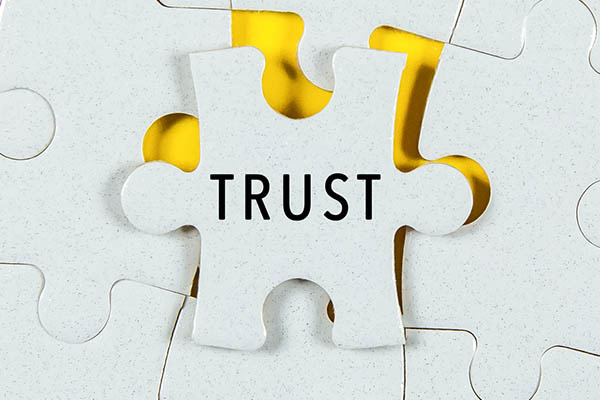
I know that you feel like you know a celebrity out there. Whether it’s Taylor Swift, Kim Kardashian, or whoever. I’m throwing out random names and you don’t know them. You have never sat in a room with them probably. You have never had a conversation with them, but there’s something about the way that they show up on TV, in interviews, or whatever where you connect to them and you are like, “I like that chick. I like that dude. I like that person.” You don’t know them, but you feel like you know them and you feel like you could be friends. That’s what we are trying to go for and you don’t want it to be forced. You want it to be you. That’s brand personality.
Next is visual brand identity. This is typically what people focus on when they think of branding and these are things like colors, fonts, logos, websites, and the whole visual side of things. You do want to have a cohesive visual brand, but it’s the least important part of brand messaging. In terms of the visual brand, you want it to be reflective of who you are, but it should represent the brand personality. It’s the least important. Start with the personality side of brand messaging. Figure out who you are and then choose some brand colors that align with that and keep them consistent. Logos don’t matter. Your website doesn’t matter. You want to keep it consistent. That visual brand should be a greater representation of the personal brand.
Finally, is the brand story. Your story is a huge part of your marketing. A lot of people are afraid to share their stories, but your story is a big part of this because there’s a very good chance that you help people with something that you once struggled with. I used to be a struggling health coach. I struggled a lot to build my business. It was hard. That helps me uniquely connect with my audience and I share the story of how I became a health coach and eventually transitioned into business coaching over and over again.
The story that you tell or your brand story is something that we develop inside Health Coach Accelerator. It is the story of how you came to be a coach professional or practitioner. How did you get here? This is a question that you are going to be asked all the time. If you do any collaborations, you are ever a guest on someone’s podcast or you do an Instagram live with someone, typically, the first question is going to be, “How did you get here? How did you get into this space?” You want to make sure you understand your brand story so you are not off on a tangent making no sense.
It should answer the question, “How did you become a coach, professional, or practitioner?” Usually, that’s the story. We don’t care about the education that you did. We care about how you suffered and how you overcame. That’s what makes a good story. For example, my story is about having a ski accident in 2011, blowing my knee, needing reconstructive surgery, and having that reconstructive surgery trigger a seven-year struggle with chronic fatigue and insomnia, which completely wrecked my life and destroyed my health.
I found myself in this situation where I couldn’t work anymore because I worked in forestry, a very physical job. I had to have knee surgery. I was trying to be a professional skier and that went out the window when I blew my knee. I lost my dreams for that. I couldn’t work. I wasn’t going to become a professional skier, and then I found myself with severe debilitating chronic fatigue. All in a day, it happened all within a couple of weeks of each other, all of that.
For me, I had to find a new career that didn’t involve using my knee, and I needed to figure out what the hell was wrong with me. That’s what ultimately drove me to become a functional health coach. My story is a bit longer than that and I tell a longer version of that story when I’m interviewed and when people ask me, but you need a story like that and your story is going to be different than mine, and that’s okay. We have all been through adversity. The journey to becoming the coach, the professional, or the practitioner is one filled with trials and tribulations with ups and downs and with struggle, and that’s what your people want to hear.
#3 Product Messaging
Finally, product messaging. This is about the offer. A lot of people when they think about the offer don’t realize that is a part of the marketing, and it is. It’s a big part of marketing. Your product does play a key part in your messaging. The product messaging conveys the features, the benefits, and the unique selling proposition of your product. How does the offer solve the customer’s problems? How does it meet their needs? How does it provide value?
There’s usually a disjoint here and I see this at all levels where people are focusing on marketing, but they are not mentioning their product enough. Their product isn’t connecting to their marketing. For example, everything I teach you guys on the show for the most part is coming out of Health Coach Accelerator. I don’t typically teach stuff that I don’t teach inside the program. If I do talk about it, I’m very explicit with that. This is not something I teach inside HCA, but this was a topic that was requested and I’m here to show up and provide value.
Remember, the intention of marketing isn’t just to market. It’s to build an audience to sell to. It’s to gain visibility and awareness so that you have people to sell to. In your marketing, people have to know you have an offer. They need to know that you have one. They need to know why it’s different and you truly need to be the biggest ambassador for your product. You should be out there shouting your offer from the rooftops and talking about it like it is the best thing since sliced bread.

This is the best thing in the world. You’d be silly for not buying it. “I love this thing so much. Look at the results it gets for this person.” Look at my program. You need to have that attitude. Your offer needs to be seeded into all of your marketing. For example, if you have hung out with me for any amount of time online, you know that my program is Health Coach Accelerator.
I talk about it all the time. I bring it up. I have already mentioned it many times in this episode. It’s not necessarily that I’m being super promotional with my offer all the time, and all I talk about is that you should sign up for HCA. That’s not what I do and that’s not what I’m telling you to do, but you have that awareness through my marketing.
It doesn’t take long before you come into my world and you are like, “Kendra Perry, and she has HCA.” You want your product to be consistent with your brand, meaning that it’s a part of your message so that people associate you, the brand, with your program. It’s important that you do this because if you are marketing to people and they don’t realize or have the awareness that you have something to sell, they are not going to buy it and they are not going to be ready to buy it when you sell it. It’s going to feel very jarring when you have been showing up providing value and suddenly, you are hammering something you want to sell down their throats.
It shouldn’t be a secret or a surprise when you start talking about your offer. It should be everywhere in your marketing. It’s important. Just to remind you that messaging is the foundation of your marketing. None of your marketing will work if you don’t work on messaging first. Even if you are in the later stages of your business, you are generating $10,000 a month or maybe even $20,000, you want to consistently come back and tweak your messaging and fine-tune it by constantly doing market research interviews, listening to your people, and switching it up as needed.
My messaging for my brand and Health Coach Accelerator has truly been years journey in the making and it’s ongoing. I have had HCA since 2019 and I worked with a copywriter to completely overhaul my messaging. Guess what? I’m probably going to do it again at some point in the future. I’m going to do market research interviews again in 2024.
It is something that we want to consistently come back to and we want to make sure we are never making assumptions or using outdated messaging. Target audience messaging, number one. Focus on that. Brand messaging, who you are, your personality, your mission, and your story, and then finally, product messaging. Make sure that your product is infused into every single stage of your marketing.
That is episode number one of the Master Your Marketing Series. I have a pretty exciting offer. This is something I haven’t offered before that I want to tell you a little bit about. I am going to be hosting a mini mastermind for higher-level practitioners. This is going to be a combination of group coaching and one-on-one, which is something that I have not offered since 2019.
It’s going to be very customized to you and where you are at in your business. What I will be teaching in this program will be completely dependent on who is in the program and what their needs are. If you are interested in applying for this mastermind and working with me over six months to reach your business goals, you need to be making at least $5,000 a month in your business consistently, and you need to have the intention to be scaling to multiple high six figures and beyond.
Maybe you are making $10,000 a month and you want to make $20,000, $30,000, or $40,000 a month. Great. This program will be perfect for you. Essentially, I will be showing and coaching you exactly how to get there. We do have some early bird pricing. I have that for the first five spots. This is going to be a very small and intimate program. The maximum is probably 12 or 13 people, but for the first round, I’m probably going to keep it even less than that.
For the first five people, we do have special pricing available, some founder member pricing. If you are interested in working with me in this program so that you can take your business from where it is now to high multiple six figures, and doing that while working 25 hours a week or less, if that sounds like something you are into, go to KendraPerry.net/apply and fill out the application. If you seem like a good fit, I will get back to you and we will have a chat.
I hope you enjoyed the first episode of the Master Your Marketing Series. In episode two, we are going to dive into organic marketing. We are going to be talking about free ways that you can market your business, including social media and some of the things that go into that. If you love this series and you know someone who would also love this series, you can send them to Go.KendraPerry.net/PodcastSeries. We are going to have all the episodes on that landing page so that you don’t have to go and find the previous ones. You can find all of them. We are going to upload them there as they become available. I hope you have a great day and I will see you in episode number two of the Master Your Marketing Series.
Important Links

